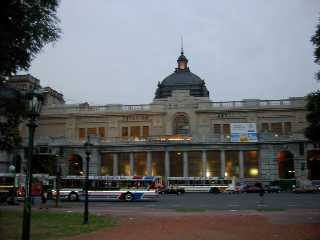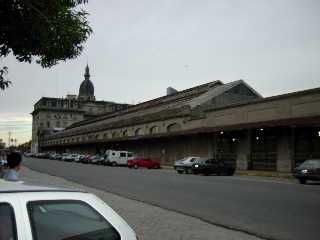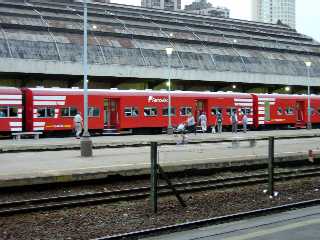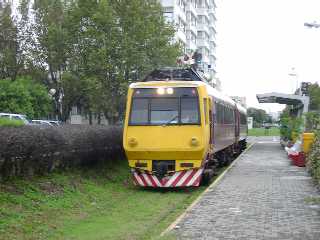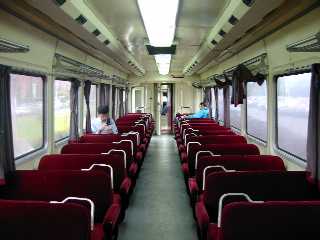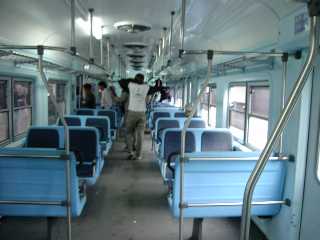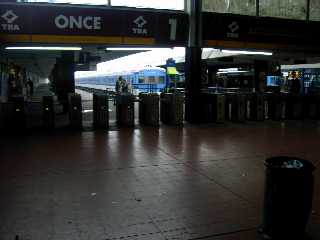Retiro is the big terminal of 3 railways(except subway) and long-term buses. These stations face to the southeast, the North Wharf(Darsena norte). Thre are are Mitre line of TBA, Ferrovvíass, Metropolitano bound for Pilar, the bus terminal(see next).
There are two tracks from each openings between the stations to southeast and there is a yard-like thing over the road and the square. There are some freight cars but it seemed not function. A track continues more and reaches to TBA's Puerto Madero station near Plaza de Mayo but some rails are bent so It is no use.
The above left is that I took Ferrovías station from a place in front of Metropolitano station. The right is Ferrovías station from the front of it. TBA is third-rail system, others are not electrified and diesel locomotives pull trains.
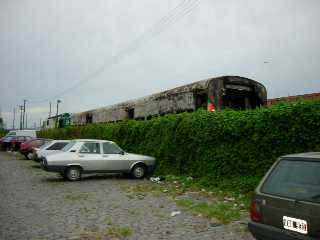 |
| A burnt car of Metropolitano Enlarge |
The 5 pictures below are all taken between Ferrovías station and Metropolitano station. The left is an abandoned car in the yard. It is burnt. I saw cars like this at carbarns on TBA Sarmient lines. Why there are so many burnt cars?
The belows are passenger cars left and the diesel locomotive right. Both are Metropolitano's. I think the shape of diesel locomotives are also seen in U.S.
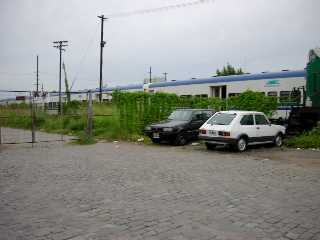 |
 |
| Metropolitano's passenger cars Enlarge |
Metropolitano's locomotive Enlarge |
The below left is taken Ferrovías station from the side of it. There are many cars. It seems that there is a free parking. There are many toll parkings around here so I wonder why this is free. The right is taken the platforms through the lattice door(locating at the right of the left picture). Cars seem the same type to Metropolitano's. The three railway companies were all national railways in former days so it is natural that same type cars are running on different companies. The locomotive is also the same to Metropolitano's and painted red. The big arched roof in the depth of the photo is TBA station.
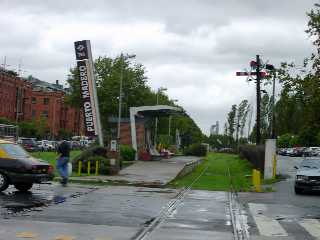 |
| Puerto Madero station of Sarmiento line Enlarge |
When we were walk around Puerto Madero we found a sight of the left picture. I thought that it was continuity of the abandoned tracks. However, the facilities are clean. We went on the platform and found a timetable. It said that there are 6 round trips a day. The fare is different in up trains in the morning and down trains in the afternoon, and, up trains in the afternoon and down trains in the morning. It may be rush hours' extra fee. But, I couldn't believe that a train runs on such a track coverd with verdure. Anyway, the day was Sunday and the timetable said trains run weekdays(Mon. thru. Fri.) so We decided to come here the next morning.
The next day, we went there and found that there was a train! There is a person in the ticket booth. We got tickets with payment of 2 pesos per person. The ticket is 7cm long and 4cm wide. There is a column scripted ASIENTO(seat) but when seats are reserved? This ticket is specified even train, not only day. The staff gave us the timetables. It said that the train we got passes 2 stations but there was handwritings 'PARA'(stops) on the 2 stations. And it stopped really. This train runs faster than other trains, it is not because of passing stations but because the train doesn't overtake 'electric' trains stopping at all stations by chance.
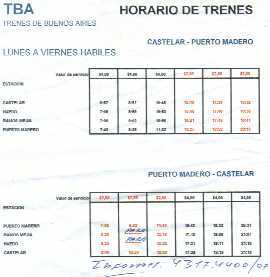 |
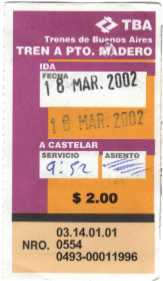 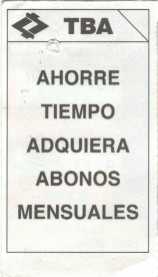 |
| Timetable between Castelar and Pto. Madero Text version |
Ticket between Castelar and Pto. Madero, left is the face and right is the reverse side. |
When boarding, what few passengers! there were only 3 persons execpt us. there are movable back seats. There is an air conditioner, rare in cars in this country, but it was cool the day so it was no mean. The train went to the depth of the above left photo, this side of the right photo, and entered a tunnel immediately. After running in the tunnel for about 10 minutes, the train exited the tunnel and met the tracks of third-rail electrified system. We didn't know where it was at the first time but after looking and looking the map, we found that it is Sarmient line departures from Once station. There are some stations for electric trains but this train needs a low platform and the tickets doesn't correspond to automatic gates so it passes stations except stations that have platforms for only this train. There are a platform for island-shape electric trains in the center, and tracks and platforms for this train at both side. Platforms for this train doesn't have ticket gates so the conductor checks tickets. This train passed stations if any passengers didn't going to get off.
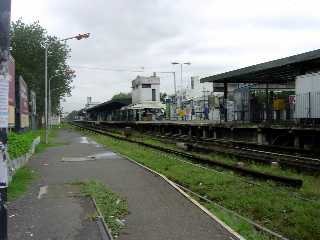 |
| Castelar station, Sarmiento line Enlarge |
We were only people who took to the terminal, Castelar. The conductor asked us where to go and going to show the way... it seemed, but we couldn't understand what he said and we could say hardly that the purpose is to ride this train itself... Finally Mr. B told it but he seemed not to understand it and shown the way to a park. I forgot where it is...
The left is Castelar, the terminal. It is the terminal for only this train so the tracks continue more. The left platform is arrival only and there is a boarding platform at the opposite side of the electric trains' platform in the right of the photo.
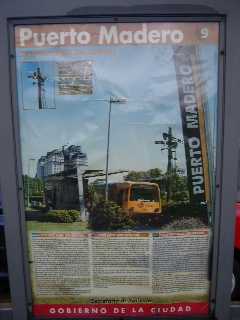 |
| The board that shows the origin of the line to Puerto Madero |
There was a board that shows the origin of the line and the tunnel. There are Spanish, English, and Portuguise. I'll show the English script below.
PUERTO MADERO STATION. RAILWAY TUNNEL.
The history of the Puerto Madero station is closely related to that of the tunnel which may be seen near Colón Park. It was built between 1912 and 1916 based on a project presented by the English engineer David Simpson to make up for the lack of direct connection between the port area and the old Sarmiento railway, today T.B.A. It was not built in the open, like the tunnel of the 'A' underground line, it was dug from both sides simultaneously and the earth was removed by a helping locomotive.
It is 4700 metres long and is an outstanding work of engineering. The entrance is in the district of Almagro on Diaz Velez Avenue and Billinghurst Street. The tunnel is 20 metres deep and has the shape of a horseshoe. At its sides shelters are to be found to be used in case of an emergency. Not having been used for a long time it was renovated in 1997 and the tunnel was used for a differential train service that joins the city of Castelar in the West of the Greater Buenos Aires with Puerto Madero, in a total run of 26 km.
For its recovery TBA installed a light system, 3 sets of ventilation, emergency exits, repair and spare parts of pumps and painted the whole run of the tunnel.
Each train formation is made up of two light motor coaches which can seat 116 passengers. The trains are very comfortable: they have air conditioning, functional music and free evening newspaper service. The success of the recovery of this service has been of great help to find a solution to the very serious transport problem from West to the metropolitan area.
...Can we get evening newspaper in the evening? It's good. Is there musics?? We didn't hear it.
  |
| TBA's magnetic ticket, left the face, right the reverse side |
The return from Castelar we thought that it is not interesting riding the same train and costs the twice so we decided to go to Once by the electric train and get Line A there. The walls facing on the suburban line's track are covered with graffiti so it seems bloody like subways in NY but Stations are very bright so it is like Japanese private railways.
We bought the tickets from a vending machine. When touching the destination it shows the fare so insert coins. You can't use bills. Maybe beacuse of it, few people use the machine and many people make row in front of ticket boothes. I couldn't find vending machines that accept bills in this country. There are coins only 1 peso or minor so it is natural that people rarely use such vending machines. Besides, There are no vending machines in subway stations although it is uniform fare so seems easy to be mechanized.
The ticket is 5.7 cm long and 5.5 cm wide, almost square. An advertisement that appeals TBA's own campaign occupies much of its faces, but I can't find what "Falgo" means... I think it means if you collect Falgos and tickets and send them to the company a ticket for Rú de Janeiro may fall upon you. By the way, There is a word "IDA". It means one way trip. Suburn railways in this city mostly sell round-trip tickets but they are simply the twice plice to one way.
The fare is 85 centavos from here to Once. From once, 70 centavos subway so it's cheaper than the diesel train. Moreover, the train is the twice fare for commuting direction. Do people ride such an expensive train?
The electric trains are painted blue like the below right photo or maroon like the diesel train. It seemed that the latter painting is older. The train we had rided was blue and it is also blue inside. The conductor is in the passenger cabin. Carrying in bicycles was permitted and there were a car that had space for bicycles. I saw many people using bicycles and some people going into buildings with them. The space in the train will be the reflection of the society. I think there had been such trains in Japan.
When getting off the train, I wanted the ticket so I use the Spanish dictionary and asked to the staff. He checked that my ticket was valid for this station and returned it with a smile. Hurrah! But the next moment, Mr.B --he passed the automatic gate ordinaly-- said, "a ticket comes out from the machine even when going out the gate." ...My negotiation became vain effort.
Please reference Sarmient Line Route Map in the TBA official page.

